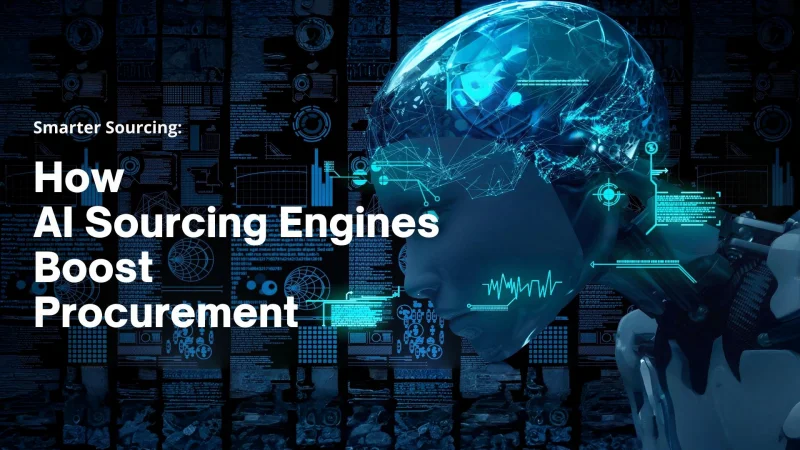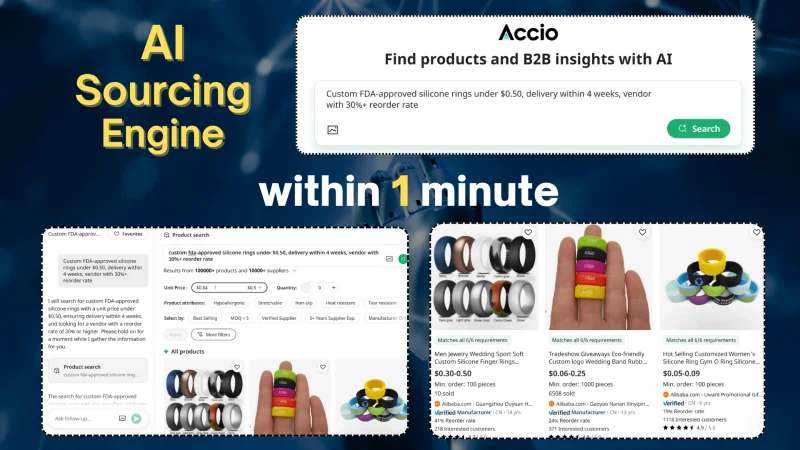Smarter Sourcing: How AI Sourcing Engines Boost Procurement

Introduction: Procurement Is Changing
Procurement isn’t what it used to be. What once took days of back-and-forth emails, PDF comparisons, and spreadsheets is now expected to move at the speed of business. Teams are under pressure to make faster, smarter, and more confident sourcing decisions—without hiring more people or blowing budgets.
That’s where artificial intelligence (AI) comes in. Once seen as a far-off concept, AI is now a practical tool changing the way procurement teams operate. It’s no longer about replacing jobs—it’s about reducing the grunt work so humans can focus on higher-value decisions. AI sourcing engines are a perfect example of that shift.
We’re also seeing a growing trend across industries: sourcing strategies are moving away from manual, static workflows and embracing more automated, intelligent systems. Businesses, big and small, are no longer satisfied with vendor spreadsheets and endless tabs. They want flexibility, transparency, and real-time insights—and AI is delivering just that.
What Is an AI Sourcing Engine?
An AI sourcing engine is like a turbocharged assistant for your procurement team. It takes what you’re looking for—product specs, budget, timelines—and finds the best supplier matches. But it doesn’t just dump a list. It prioritizes results based on factors like lead time, reviews, cost, and more.
This smart engine also adapts. Rather than rigid search filters, it uses natural language and real-time data to personalize results. You spend less time chasing quotes and more time comparing qualified options.
The best part? These tools often integrate with systems you already use. No need to rebuild your workflow. Just plug in, and you get faster sourcing, clearer comparisons, and fewer headaches.
And it’s not just for procurement pros. Operations leads, startup founders, even product managers can benefit. The learning curve is minimal, and the payoff is immediate.

Real Results: How AI Sourcing Helps Different Teams
You don’t need a big team or budget to benefit from AI. In fact, lean businesses often see the biggest returns.
Let’s look at some common use cases:
- Startups: A solo buyer can source quotes from vetted suppliers in minutes.
- Global sourcing: Teams can quickly find reputable suppliers in new regions—complete with trade history.
- Custom parts: AI can match unique requirements with manufacturers that specialize in niche categories.
One California electronics brand proved this. When their top supplier delayed orders by 40%, they used an AI sourcing engine to identify three strong alternatives within 48 hours. One had faster lead times and better terms. That pivot saved them over 15 hours of manual research—and their production line.
AI sourcing also supports broader goals. For instance, sustainability teams can use ESG filters to screen suppliers who meet environmental or ethical standards.
In short, AI upgrades sourcing from manual guesswork to intelligent decision-making—saving time, expanding your options, and improving results.
For larger teams, AI engines can also unify internal collaboration. Instead of multiple departments vetting the same suppliers independently, AI helps centralize data, flag duplicates, and streamline approvals. This reduces miscommunication and accelerates decision-making across functions.
AI also enables better forecasting. By analyzing historical purchasing data, seasonal trends, and market movements, AI sourcing engines can help predict future needs and pricing shifts. This allows companies to buy more strategically—ordering ahead when prices are favorable and avoiding rush fees or shortages.
Teams can even simulate different procurement scenarios using AI tools. For example, they can compare what happens to costs or delivery time if they switch suppliers, change MOQs, or source from a new region. These what-if simulations allow for confident, data-backed decisions.
The Industry Is Changing—Fast
Why is this shift happening now?
Three big forces are pushing AI into the procurement spotlight:
- Overwhelming data: Supplier directories are massive. Manual comparison isn’t scalable.
- Speed expectations: Businesses want quotes and lead times in real time.
- Better tools: AI tech is more accessible than ever—faster, cheaper, and easier to use.
And it’s catching on. Surveys show 60% of small and midsize procurement teams are testing or using AI sourcing tools. The need for agile, insight-driven procurement is no longer a luxury—it’s a necessity.
Today’s AI doesn’t just search. It understands product specs, flags potential red flags, and even recommends negotiation opportunities. These aren’t just dashboards—they’re decision accelerators.
Moreover, as global supply chains face increasing disruption—from geopolitical shifts to climate-related delays—organizations are turning to AI not just for convenience, but for resilience. AI tools enable rapid re-sourcing, simulate risk scenarios, and help procurement leaders build contingency plans before crises occur.
The impact of AI also extends to vendor performance monitoring. By continuously analyzing delivery patterns, compliance issues, and pricing trends, AI gives teams a proactive edge. Rather than waiting for problems to surface, they can spot and solve them early.
Another major factor is the rise of remote work and distributed teams. AI sourcing tools support asynchronous collaboration by keeping supplier data centralized and accessible. Team members across time zones can review quotes, share notes, and make decisions without endless meetings or missed updates.
As procurement becomes more digital, AI plays an even bigger role in ensuring that sourcing decisions are aligned with both short-term goals and long-term strategy.
From Optional to Essential
AI sourcing engines have gone from nice-to-have to must-have. With supply chains under pressure and teams stretched thin, tools that cut friction and boost confidence are now essential.
What’s more, AI doesn’t replace human judgment—it amplifies it. By surfacing insights and reducing noise, these tools allow teams to stay in control while moving faster than ever.
Even niche industries—from medtech to eco-packaging—are seeing AI level the playing field. Smaller companies now have access to sourcing intelligence once reserved for big players.
Forward-looking companies are already building their procurement strategies around these tools. They’re not just improving efficiency—they’re building a sourcing advantage that scales with growth.
The bottom line: companies that embrace AI sourcing early will be better prepared for what’s next. Whether it’s inflation, supply shocks, or shifting customer demands, they’ll have the agility and intelligence to adapt.

Final Thoughts: Make Smarter Choices, Faster
AI sourcing engines are changing procurement not by replacing people, but by removing the parts of the job no one enjoys—manual comparisons, endless tabs, unclear quotes.
The message is clear: if you want faster decisions, better visibility, and fewer delays, it’s time to make AI a core part of your procurement toolkit, the tools are ready. The ROI is proven.
Smarter sourcing starts with smarter tools. And the smartest teams are already ahead.
Ti potrebbe interessare:
Segui guruhitech su:
- Google News: bit.ly/gurugooglenews
- Telegram: t.me/guruhitech
- X (Twitter): x.com/guruhitech1
- Bluesky: bsky.app/profile/guruhitech.bsky.social
- GETTR: gettr.com/user/guruhitech
- Rumble: rumble.com/user/guruhitech
- VKontakte: vk.com/guruhitech
- MeWe: mewe.com/i/guruhitech
- Skype: live:.cid.d4cf3836b772da8a
- WhatsApp: bit.ly/whatsappguruhitech
Esprimi il tuo parere!
Che ne pensi di questa notizia? Lascia un commento nell’apposita sezione che trovi più in basso e se ti va, iscriviti alla newsletter.
Per qualsiasi domanda, informazione o assistenza nel mondo della tecnologia, puoi inviare una email all’indirizzo [email protected].
Scopri di più da GuruHiTech
Abbonati per ricevere gli ultimi articoli inviati alla tua e-mail.
